In this section, we will guide you through the process of mastering the Firefly Pose, a challenging arm balance in yoga. Also known as Tittibhasana, this pose requires strength, flexibility, and balance to achieve.
You will learn how to do Firefly pose in a very detailed step by step guide.
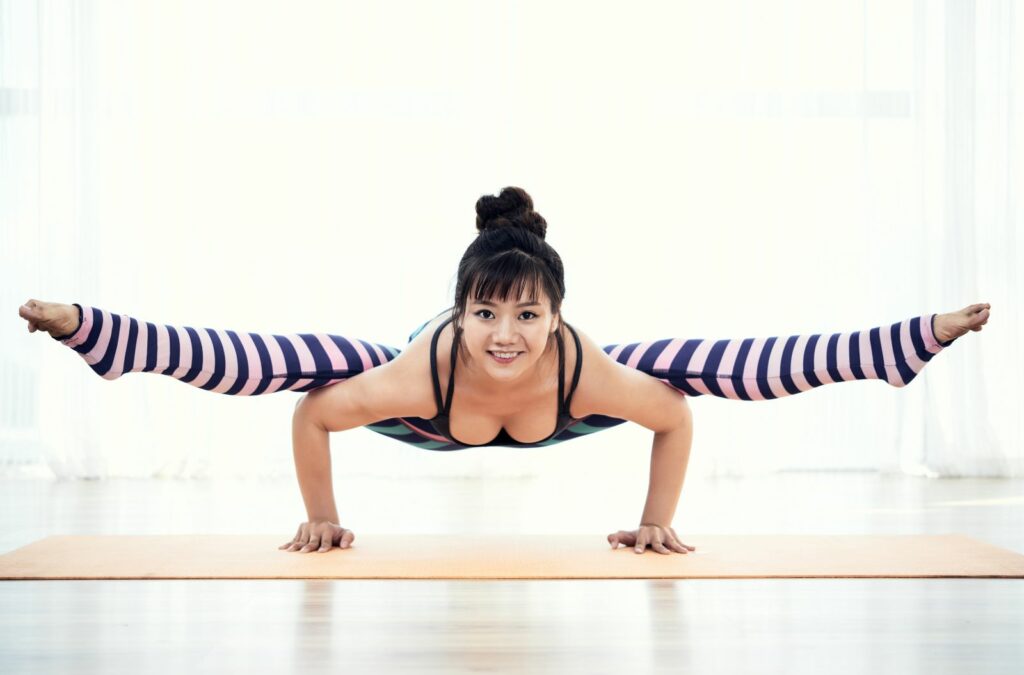
How to Do Firefly Pose
The Firefly Pose, or Tittibhasana in Sanskrit, is an advanced yoga pose that falls into the category of arm balances and hip openers. Its primary goals and benefits are as follows:
- Strength Building: Firefly Pose requires significant arm and core strength. Practicing this pose helps to develop strength in the wrists, arms, and abdominal muscles.
- Balance and Concentration: Achieving and maintaining the pose demands a strong sense of balance and concentration. Balancing on your hands with extended legs challenges your mental focus and body control.
- Hip Flexor Flexibility: This pose involves a deep opening of the hip flexors and groins. Regular practice can improve hip flexibility and range of motion.
- Inner Thigh and Adductor Stretch: While in Firefly Pose, the inner thighs and adductors are stretched and engaged, contributing to improved leg flexibility.
- Full Body Awareness: The pose requires a holistic approach to the body, involving coordination and engagement of multiple muscle groups, leading to an increased awareness of your body’s capabilities.
- Stress Reduction: As with many yoga poses, practicing Firefly can help reduce stress and anxiety by promoting mindfulness and relaxation through breath control.
Firefly Pose is often part of advanced yoga sequences, and mastering it can be a fulfilling accomplishment for experienced yogis. It is essential to approach this pose with patience, and under the guidance of an experienced yoga instructor to avoid injury and make the most of its physical and mental benefits.
So lets dive in …
Key Takeaways:
- Warm up your body with wide-legged forward bends to wake up hip flexion and stretch your hamstrings.
- Prepare your shoulders with binds like baddha parsvakonasana and a bent-knee one-leg-bound uttanasana.
- Begin in a wide-legged bent-leg uttanasana position and gradually work your shoulders under your thighs.
- Hug your inner thighs into your upper arms and externally rotate your upper arms.
- Press your hands into the floor, engage your core, and lift your heels to balance on your toes.
- Explore different variations of Firefly Pose to find what works best for you.
- Synchronize your breath and movements to create a mind-body connection in the pose.
- Warm up properly and avoid the pose if you have any injuries or sensitivities.
- Practice in a safe environment and consult with a teacher for proper instruction and advice.
Benefits of Firefly Pose
Firefly Pose offers a range of benefits for both the body and mind, making it a worthwhile addition to your yoga practice. This challenging arm balance pose strengthens the arms, shoulders, and core muscles, promoting overall upper body strength. Holding the weight of the body on the hands also increases wrist strength and stability.
In addition to building strength, Firefly Pose improves flexibility, particularly in the hamstrings and hips. The wide-legged forward bends and hip-opening poses that are part of the preparatory sequence help lengthen and stretch these areas, allowing for deeper and more comfortable engagement in the pose. This increased flexibility enhances overall mobility and range of motion.
Firefly Pose also helps to improve balance and body awareness. The pose requires a strong connection between the core and the legs, as well as a keen understanding of weight distribution. As you learn to find your balance in Firefly Pose, you develop a greater sense of proprioception and body control.
Finally, Firefly Pose offers mental benefits by cultivating mindfulness and focus. The pose requires concentration and attention to detail, as you coordinate the movement of your body while maintaining steadiness and balance. This focus on the present moment helps to quiet the mind and create a sense of calm and inner peace.
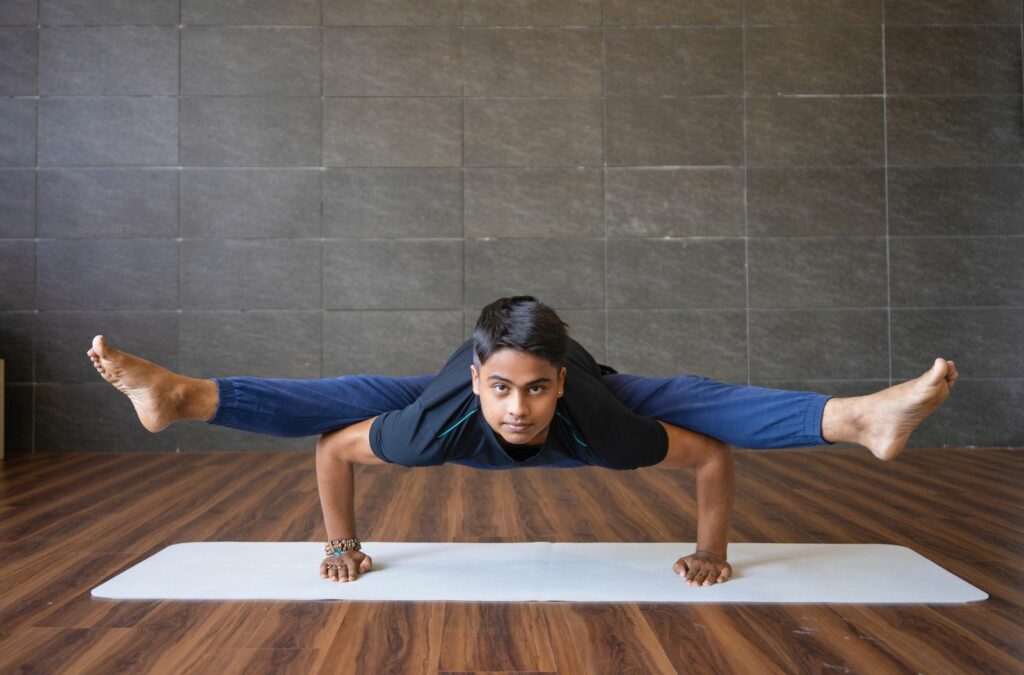
Preparatory Poses for Firefly Pose
Before attempting Firefly Pose, it is crucial to prepare your body through a series of warm-up poses that target the hips and hamstrings. These preparatory poses will help awaken the necessary muscle groups and increase flexibility, enabling you to perform Firefly Pose with greater ease and stability.
Wide-Legged Forward Bends
Start by standing at the top of your mat with your feet wide apart. Take a deep inhale, and as you exhale, hinge forward from your hips and place your hands on the floor in front of you. Allow your upper body to relax and let gravity pull you down, releasing any tension in your hips and hamstrings. You can keep your legs straight or slightly bent, depending on your flexibility level. Hold this pose for several breaths, feeling the stretch in your inner thighs and the back of your legs.
Upavistha Konasana, or Wide-Angle Seated Forward Bend, is another excellent preparatory pose for Firefly Pose. Sit on the floor with your legs spread wide apart, forming a V-shape. Inhale deeply, and as you exhale, fold forward from your hips, lengthening your spine and reaching your hands toward your feet. Keep your legs engaged and press your sit bones down into the ground. This pose will further stretch your inner thighs and hamstrings, preparing your body for the demands of Firefly Pose.
Hip Flexion and Hamstring Stretch
As you move deeper into your warm-up routine, it is essential to focus on hip flexion and hamstring stretches. These movements will enhance the range of motion in your hips and increase the flexibility of your hamstrings, both of which are crucial for Firefly Pose.
One effective pose for hip flexion is Eka Pada Rajakapotasana, or Pigeon Pose. Begin in a tabletop position and slide one knee forward, placing it behind your wrist.
Extend the opposite leg behind you, keeping your hips square. Lower your upper body onto your forearms or a bolster, allowing your hips to relax and sink toward the floor. Hold this pose for several breaths, feeling the deep stretch in your hip flexors.
For a hamstring stretch, consider practicing Prasarita Padottanasana, or Wide-Legged Standing Forward Bend. Stand with your feet wide apart and fold forward from your hips, reaching your hands toward the floor.
You can grab onto your ankles or place your hands on blocks for support. Keep your legs engaged and firm, feeling the lengthening sensation in your hamstrings. Take slow, deep breaths as you hold the pose, allowing your body to gradually open up and release tension.
Complete Table:
| Preparatory Poses | Description |
|---|---|
| Wide-Legged Forward Bends | Standing with feet wide apart, hinge forward from the hips to stretch inner thighs and hamstrings. |
| Upavistha Konasana | Sitting with legs spread wide apart, fold forward to deepen the stretch in inner thighs and hamstrings. |
| Hip Flexion and Hamstring Stretch | Practice Eka Pada Rajakapotasana (Pigeon Pose) for hip flexion and Prasarita Padottanasana (Wide-Legged Standing Forward Bend) for hamstring stretch. |
Preparing the Shoulders for Firefly Pose
Ensuring proper shoulder preparation is essential for successfully performing Firefly Pose, and this section will guide you through effective shoulder-opening exercises.
By incorporating shoulder-opening binds such as baddha parsvakonasana (bound extended side angle pose) and a bent-knee one-leg-bound uttanasana (standing forward fold), you can enhance your range of motion and flexibility in the shoulders, enabling a smoother transition into Firefly Pose.
To begin, warm up your body by performing baddha parsvakonasana. From a lunge position, bring your front arm underneath and behind your front thigh, clasping it with your back hand. This deep bind will help open the shoulders and create space for the arms to move freely in Firefly Pose. Hold this pose for 5 breaths on each side, focusing on deepening the bind with each exhale.
Next, move into a bent-knee one-leg-bound uttanasana. Start in a standing position with your feet hip-width apart. Bend your knees deeply, allowing your torso to fold forward between your thighs. Reach your arms behind your legs and clasp your hands together, creating a bind.
This pose not only stretches the shoulders but also engages the core and strengthens the legs, which are essential for stability in Firefly Pose. Take 5 breaths in this pose, focusing on grounding through the feet and lengthening the spine.
By incorporating these shoulder-opening binds into your practice, you will prepare the shoulders for the demands of Firefly Pose. Remember to move mindfully, respecting your body’s limitations, and consulting with a qualified yoga teacher if you have any questions or concerns.
With consistent practice and proper preparation, you will gradually build the strength and flexibility necessary to master Firefly Pose.
Getting into Firefly Pose
Now that you’re properly warmed up, let’s explore the step-by-step process of getting into Firefly Pose, also known as Tittibhasana. This challenging arm balance pose requires proper hand placement and weight distribution to achieve balance and stability.
Start in a wide-legged bent-leg uttanasana position, with your feet wider than hip-width apart. Bend your knees deeply and place your hands on the floor in front of you, shoulder-width apart, fingers pointing forward.
Take a moment to ensure that your hands are positioned securely and that your fingers are spread wide for added stability. From here, slowly work your shoulders under your thighs, one at a time. As you do this, you may need to lift your heels slightly and shift your weight to your hands.
Eventually, aim to place your palms flat on the floor or on blocks behind you, with your fingers pointing forward. As you settle into the pose, hug your elbows toward each other, externally rotate your upper arms, and press your hands firmly into the floor.
This will help you create a strong foundation for the pose. To maintain balance, engage your core by drawing your navel in toward your spine and hugging your inner thighs toward the midline of your body. Lift your heels, balancing on the tips of your toes, and spread your toes to lift them away from the floor.
Once you have found stability in Firefly Pose, it’s time to “brighten” your feet. Uncross your ankles and straighten your legs, reaching through the balls of your feet.
This will create a sense of extension and add to the overall elegance of the pose. Remember to listen to your body and respect its limits. If you have any injuries or sensitivities in your shoulders, elbows, wrists, or lower back, it’s best to avoid this pose.
Practice Firefly Pose in a safe environment and consult with a qualified yoga teacher for proper instruction and guidance. Now, let’s explore a table that summarizes the key steps for getting into Firefly Pose:
| Step | Description |
|---|---|
| 1 | Start in a wide-legged bent-leg uttanasana position |
| 2 | Place your hands on the floor, shoulder-width apart, fingers pointing forward |
| 3 | Work your shoulders under your thighs, one at a time |
| 4 | Hug your elbows toward each other and press your hands into the floor |
| 5 | Engage your core and lift your heels, balancing on the tips of your toes |
| 6 | Uncross your ankles and straighten your legs, reaching through the balls of your feet |
In Firefly Pose, synchronize the elements of the pose to awaken your entire body. Enjoy the journey of finding balance and strength as you explore this illuminating posture.
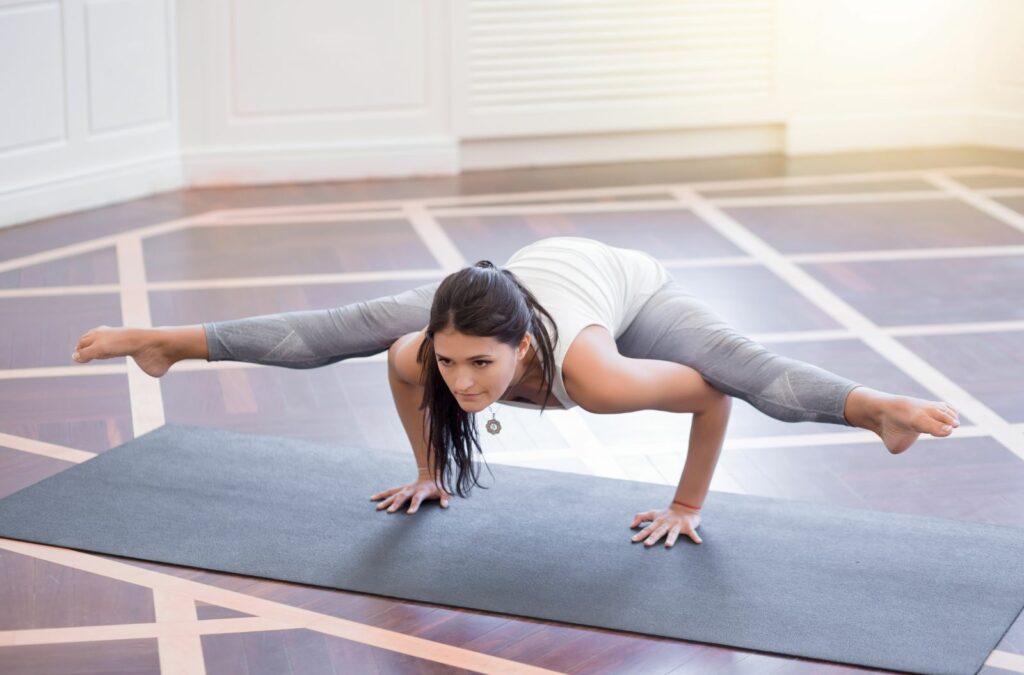
Finding Balance in Firefly Pose
Achieving balance in Firefly Pose requires the integration of various elements, and this section will guide you through the important aspects to focus on. To begin, find a calm and focused state of mind as you approach the pose. Mindfulness plays a crucial role in maintaining balance and stability. Take a moment to connect with your breath, bringing your awareness to the present moment.
Leg engagement is another essential element in Firefly Pose. As you lift your legs off the ground, squeeze your inner thighs into your upper arms. This action helps to create a strong connection between the upper and lower body, providing a solid foundation for the pose. Focus on keeping the legs engaged throughout the entire duration of the pose.
Core activation is key to maintaining balance and control in Firefly Pose. Engage your core muscles by drawing your navel in towards your spine. This will help to stabilize your torso and prevent any excess movement or wobbling. Keep the core engaged throughout the pose to maintain a sense of control.
Breath control is essential in Firefly Pose as it helps to calm the mind and regulate your energy. Take slow, deep breaths, paying close attention to the inhales and exhales. Allow your breath to flow smoothly and evenly, grounding yourself in the present moment. This conscious breathing will not only enhance your balance but also promote a sense of calm and focus.
Variations of Firefly Pose
Firefly Pose offers room for creativity and personalization, and this section will introduce you to a few variations that you can experiment with.
- Supported Firefly Pose: If you’re new to Firefly Pose or want some extra support, you can use props like blocks or bolsters. Place the props under your hands, allowing them to elevate your palms off the floor. This modification can help you build strength and confidence in the pose.
- One-Legged Firefly Pose: As the name suggests, this variation involves lifting one leg off the floor while maintaining the balance of the pose. Begin in Firefly Pose and slowly extend one leg straight out in front of you, parallel to the floor. Engage your core and focus on maintaining stability as you hold the pose. This variation challenges your balance and strengthens your leg muscles.
- Advanced Firefly Pose: Once you have mastered the basic Firefly Pose, you can explore more advanced variations. For example, you can try straightening both legs and extending them out in front of you while maintaining the arm balance. This variation requires additional strength and flexibility in the hamstrings and shoulders.
Remember to listen to your body and only attempt variations that feel comfortable and appropriate for your level of practice. It’s important to approach these variations with patience and respect for your body’s limitations.
Experimenting with these variations can add depth and challenge to your Firefly Pose practice. Take your time, explore your boundaries, and enjoy the journey of discovering what works best for your body. Remember, adaptability is key, so feel free to modify these variations to suit your personal preferences and abilities.
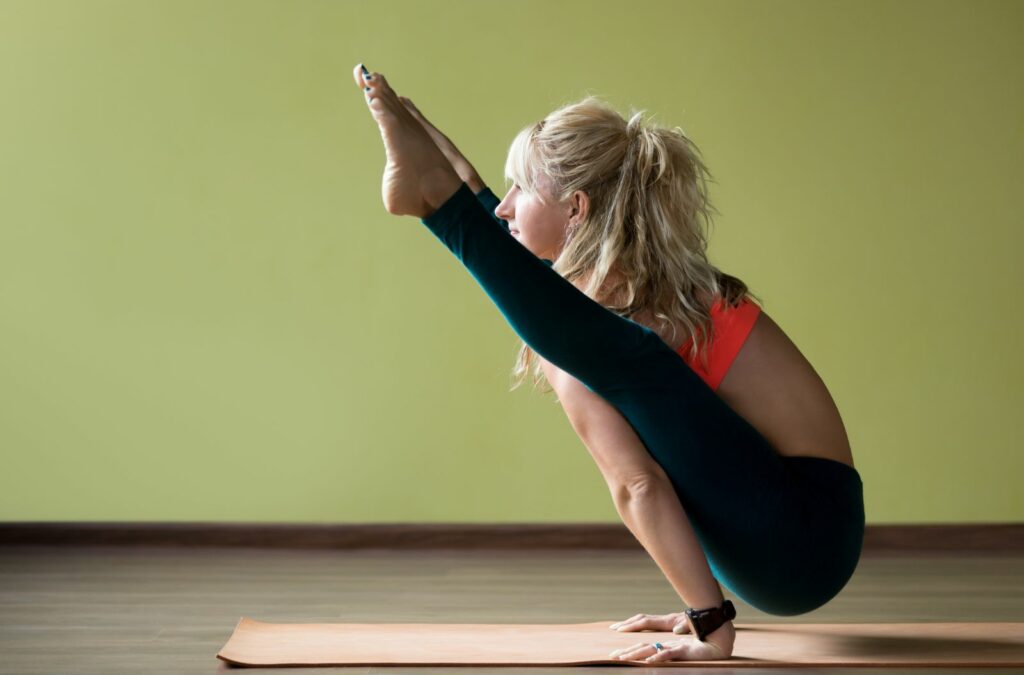
Safety Considerations and Contraindications
While Firefly Pose can be a rewarding pose to master, it’s crucial to approach it with caution and prioritize safety. Practicing this challenging arm balance requires strength, flexibility, and proper technique. Before attempting Firefly Pose, it’s important to warm up your body and ensure you are in good physical condition. Here are some safety considerations and contraindications to keep in mind:
- Shoulder Integrity: Firefly Pose requires significant strength and stability in the shoulders. If you have any shoulder injuries or sensitivities, it’s best to avoid this pose or modify it with the guidance of a qualified yoga teacher.
- Wrist Health: The wrists bear a considerable amount of weight in Firefly Pose, so it’s essential to have sufficient wrist strength and flexibility. If you have any wrist issues, such as carpal tunnel syndrome or wrist instability, it’s advisable to avoid or modify this pose.
- Lower Back Sensitivities: Firefly Pose involves rounding the lower back while balancing on the arms, which can put strain on the lumbar spine. If you have a history of lower back injuries or sensitivities, it’s crucial to approach this pose with caution and practice with proper alignment and support.
- Elbow and Forearm Health: The pressure on the elbows and forearms in Firefly Pose can be intense. If you have any elbow or forearm conditions, such as tennis elbow or tendinitis, it’s advisable to avoid or modify this pose to prevent exacerbating these issues.
Remember that every practitioner is unique, and it’s important to listen to your body and honor any limitations or restrictions you may have. If you’re unsure about whether Firefly Pose is suitable for you, it’s always best to seek guidance from a knowledgeable yoga teacher.
| Contradictions | Modifications |
|---|---|
| Injuries or sensitivities in the shoulders, elbows, wrists, or lower back | Work with props such as blocks or a bolster to provide support and make the pose more accessible. Alternatively, opt for a modified version of the pose that puts less strain on the affected areas. |
| Pre-existing conditions such as carpal tunnel syndrome, tennis elbow, or tendinitis | Avoid putting excessive pressure on the wrists and forearms. Modify the pose by using props to reduce the load on these areas or choose an alternative arm balance that is more suitable for your condition. |
| Weak or unstable shoulders | Build strength and stability in the shoulders through targeted exercises and preparatory poses before attempting Firefly Pose. Work with a yoga teacher to ensure proper alignment and avoid placing excessive strain on the shoulders. |
| Lower back issues such as herniated disc or chronic pain | Avoid rounding the lower back excessively in Firefly Pose. Focus on engaging the core to support the lower back and listen to your body’s limits. Modify the pose by using props or choose an alternative arm balance that is gentler on the lower back. |
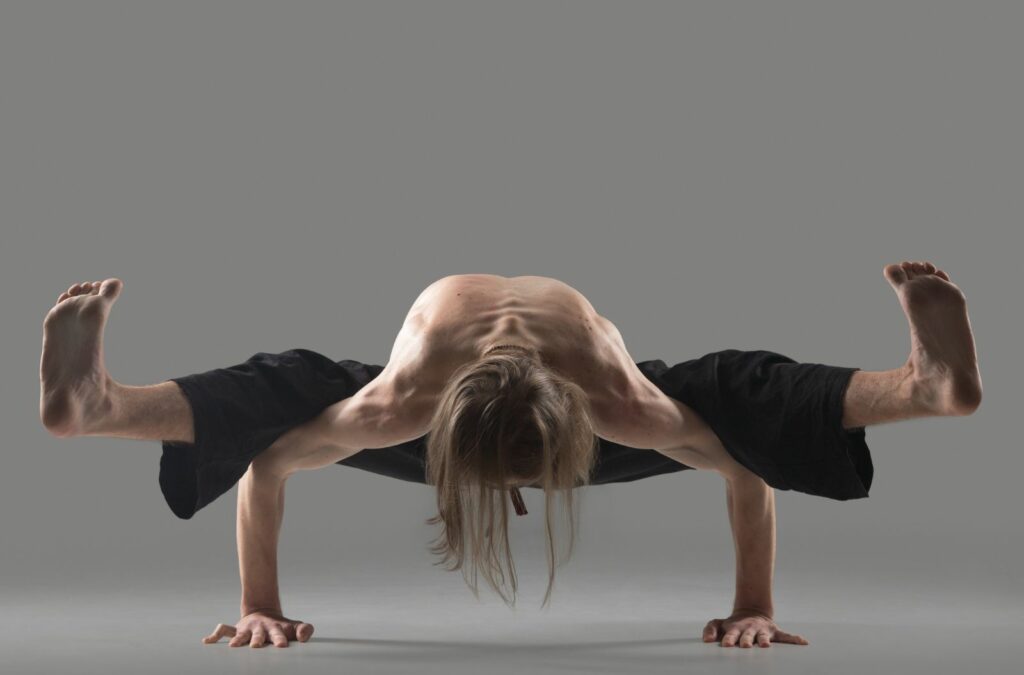
Tips for Progressing in Firefly Pose
Mastering Firefly Pose takes time and dedication, and this section will offer advice on how to progress and develop your skills in this challenging arm balance. With consistent practice and patience, you can gradually improve your strength, flexibility, and balance in Firefly Pose.
Here are some tips to help you progress:
- Warm up properly: Before attempting Firefly Pose, it is important to warm up your body. Start with wide-legged forward bends like prasarita padottanasana and upavistha konasana to wake up hip flexion and abduction. These poses will also stretch your hamstrings, which is important for Firefly Pose.
- Build shoulder strength and flexibility: Strong and open shoulders are essential for Firefly Pose. Incorporate shoulder-opening binds such as baddha parsvakonasana and a bent-knee one-leg-bound uttanasana to prepare your shoulders for the pose.
- Focus on proper alignment: When getting into Firefly Pose, ensure that your palms are placed flat on the floor or on blocks behind you, with fingers pointing forward. Hug your elbows toward each other, externally rotate your upper arms, and engage your core to maintain stability.
- Work on leg engagement: Squeeze your inner thighs into your upper arms to keep your legs in the air and attached to the upper body. As you progress, you can uncross your ankles and straighten your legs, reaching out through the balls of your feet.
- Harness the power of your breath: The mind-body connection is crucial in Firefly Pose. Stay present and focused by syncing your breath with the movements of the pose. Find a rhythm and pace that works for you.
Remember, progress in Firefly Pose is a journey, not a destination. Be gentle with yourself, listen to your body, and honor your limits. If you have any injuries or sensitivities in your shoulders, elbows, wrists, or lower back, it is important to avoid the pose or seek guidance from a qualified yoga teacher. Practice in a safe environment and seek proper instruction to ensure a safe and effective practice.
Quote:
“Progress is not achieved by luck or chance but by consistent practice, patience, and perseverance.” – Jannie Dawson
The Mind-Body Connection in Firefly Pose
Firefly Pose not only challenges the physical body but also offers an opportunity to deepen the mind-body connection, and this section will delve into the mindful aspects of the pose. As you move through the steps of Firefly Pose, it’s crucial to bring awareness to your breath and cultivate mindfulness.
Mindfulness starts with breath awareness. As you find your balance in Firefly Pose, pay attention to your breath, inhaling deeply and exhaling fully. Focus on the sensation of the breath flowing in and out of your body, and let it guide your movements. By directing your attention to the present moment and the rhythm of your breath, you can bring a sense of calm and centeredness to the pose.
In Firefly Pose, the mind-body connection is strengthened as you synchronize all the elements of the pose. From the alignment of your arms and shoulders to the engagement of your core and legs, each component requires focus and concentration. By staying present and mindful of each movement, you can create a seamless connection between your mind and body, enhancing your overall yoga practice.
As you explore Firefly Pose, remember to approach it with patience and compassion. The mind-body connection is a journey that requires time and practice to cultivate. Embrace each attempt as an opportunity to learn and grow, and be gentle with yourself throughout the process. With consistent practice and an open mind, you can deepen your mind-body connection in Firefly Pose and unlock the full transformative potential of this empowering yoga pose.
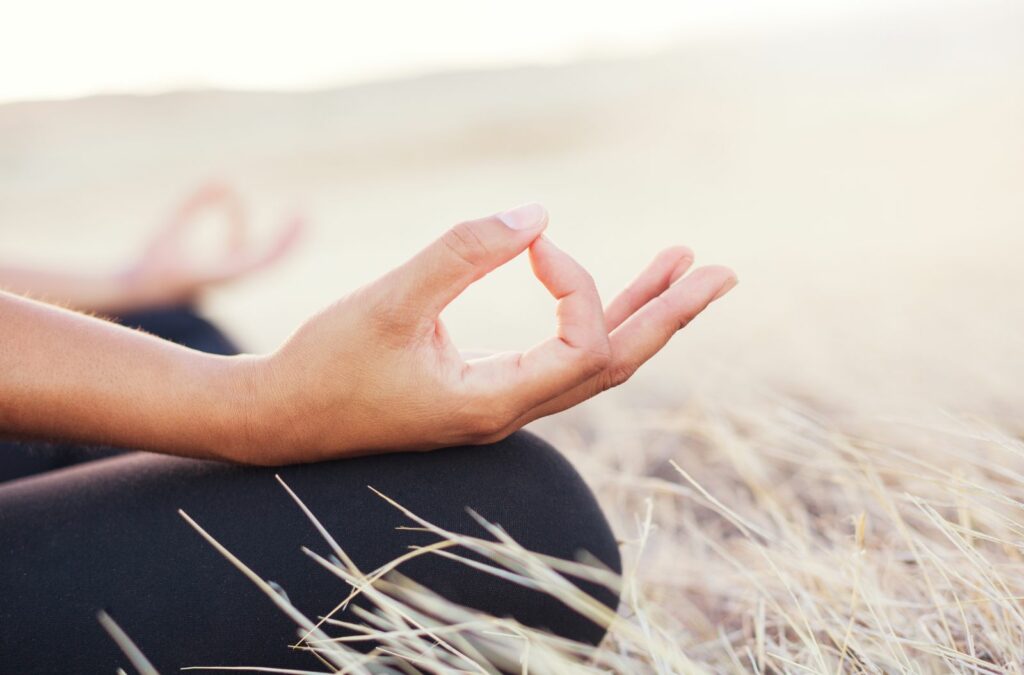
In Conclusion
Firefly Pose, with its challenging yet rewarding nature, offers a path to finding new strength and perspective in your yoga practice. By warming up the body and preparing the shoulders, you can safely and effectively enter into this arm balance pose. Starting from a wide-legged bent-leg uttanasana position, you’ll gradually shift your weight onto your hands, engaging the core and legs to find balance.
As you progress in Firefly Pose, you have the opportunity to explore variations that suit your personal preferences and adaptability. Whether you choose to focus on strength, balance, or flexibility, there is room for growth and improvement. Consistent practice, patience, and a mindful approach will lead to gradual progress in this pose.
Firefly Pose not only challenges the physical body but also cultivates a strong mind-body connection. By staying present with your breath and practicing mindfulness, you can deepen your experience in the pose and connect with your inner self. Embrace the journey of Firefly Pose and discover the transformative power it holds.
Katty Linsky, a certified Restorative Yoga teacher based in the vast landscapes of Russia, has dedicated herself to the art of yoga.
Her journey through yoga, particularly the gentle practice of Restorative Yoga, has been a transformative and enlightening one, rooted in a deep passion for holistic wellness and a commitment to sharing its benefits.

